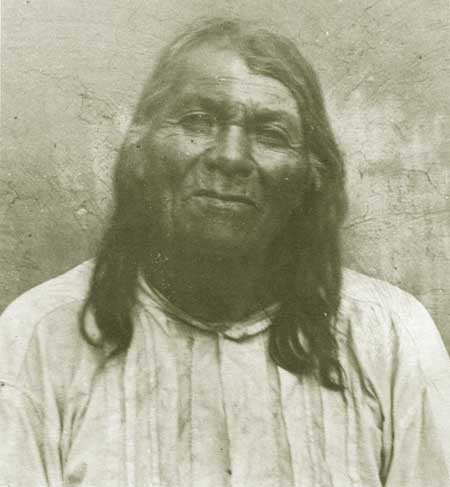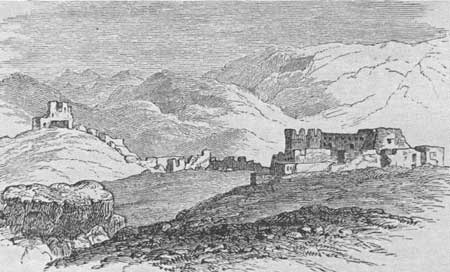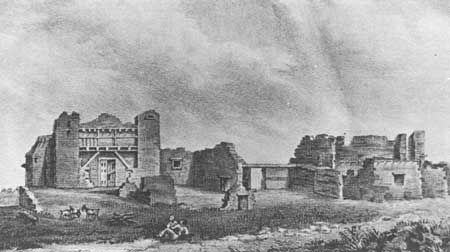

Contents Foreword Preface The Invaders 1540-1542 The New Mexico: Preliminaries to Conquest 1542-1595 Oñate's Disenchantment 1595-1617 The "Christianization" of Pecos 1617-1659 The Shadow of the Inquisition 1659-1680 Their Own Worst Enemies 1680-1704 Pecos and the Friars 1704-1794 Pecos, the Plains, and the Provincias Internas 1704-1794 Toward Extinction 1794-1840 Epilogue Abbreviations Notes Bibliography |
Actually, neither people nor place really died. They simply parted company. At Jémez pueblo, the Pecos refugees settled into homes and planted fields provided by their hosts, but they did not forget who they were. They spoke the same language, noted Lt. James H. Simpson in 1849, but they "differ somewhat in their religious customs." They did not forget even as one generation followed upon the next. Studying Jémez in the early 1920s, anthropologist Elsie Clews Parsons came away with the impression
The Jémez people had welcomed the remnant of powerful Pecos. These immigrants, headed by Juan Antonio Toya, brought with them religious objects and practices to add to those of Jémez. They brought with them the Pecos bull, and fetiches, and the Pecos Eagle Catchers' society. And they brought an image of Nuestra Señora de los Ángeles, La Porciúncula, whose feast, August 2, the pueblo of Jémez began to celebrate along with that of its own patron San Diego. Not everything they carried from Pecos stayed at Jémez however. In 1882, for example, Judge L. Bradford Prince "obtained" from Pecos immigrant Agustín Cota a wooden plaque of Our Lady of the Angels from the mission church at Pecos, or so Cota led Prince to believe.
They did not forget. From time to time they made pilgrimages back to their ancestral home, where they continued to maintain shrines. Another link, forged mainly of paper by agencies of the United States government, bound the displaced Pecos and the memory of the land they had once occupied. For more than a century, from 1855, when a claim to the Pecos league was filed in behalf of "the inhabitants of Pecos Pueblo," until 1959, when the Indian Claims Commission dismissed the last Pecos bid for additional compensation, the existence of a recognizable community of Pecos Indians at Jémez vaguely disquieted those who took up the land in their absence. Not that the Pecos ever seriously thought of reoccupying their league. They were too few. Besides, Hispanos had long been farming the good land along the river. What they wanted, they explained to Superintendent of Indian Affairs Michael Steck in 1864, was permission to sell the 18,763.33 acres confirmed to them by Congress. Steck promised to ask the commissioner in Washington. The claimants, all residents of Jémez, now numbered seven men and twenty-five women and children. Because the Pecos Pueblo grant included several hundred acres of fine farm land "and one of the best water powers in the Territory," its sale, Steck though, could bring $10,000 or more. Later in 1864, the government issued a patent. Juan Antonio Toya now had a paper.
Four years hence, Toya and ten others, three of them women, put their x's on paper and their grant in the hands of indispensable, resilient, sometimes drunken John N. Ward, special agent to the Pueblos, their friend. For $10.00 they sold to Ward the northern quarter outright, that portion already encroached upon by Hispano residents of Pecos village. At the same time, they gave him power of attorney to sell the rest in their behalf. Ward cast about for a buyer. The U.S. Supreme Court, meantime, lent its support, deciding in United States v. Joseph (1876) that the Pueblo Indians were not wards of the government and therefore, like other citizens, could dispose of their property as they saw fit. By 1872, Ward had found his buyer, the debonair Las Vegas merchant and speculator Frank Chapman. The price to the Pecos for their three-quarters was $4,000, the price to Ward for his quarter, $1,300. That should have been that, as far as the Pecos were concerned, but it was not. Forty years down the road—after title to the grant had changed hands several times, at least once over a meal in a New York restaurant, after "a large hotel scheme for the ruins of Pecos" was scrapped and a fortune made cutting railroad ties, after purchase by the mercantile firm of Gross, Kelly and Company—the Supreme Court reversed itself. It found in United States v. Sandoval (1913), marvelous to relate, that the Pueblo Indians had been wards of the government after all. Therefore they could not have alienated their lands. Therefore Gross, Kelly and Company's paper title was invalid, or was it? Therefore the Hispanos of Pecos village were illegal squatters, or were they?
The outcry was resounding. Dozens of lawyers hurried into the fray, along with champions of Indian rights like John Collier and Stella Atwood. One estimate put the number of non-Indian, property-holding trespassers on Pueblo grants at three thousand. Were they all to be ejected and the lands restored to the Indians? Were they to be compensated? Or were they to stay put and let the government compensate the Indians? And what about a long-abandoned pueblo like Pecos? On the advice of white friends, Pablo Toya, son of Juan Antonio, requested in 1921 a certified copy of the patent to the Pecos Pueblo grant. The paper issued to his father had been lost. The three-man Pueblo Lands Board, created by Congress in 1924 to identify all valid non-Indian holdings within the external boundaries of recognized Pueblo Indian grants or purchases and to assess the Pueblos' losses, did not get around to Pecos until 1929. Even though, the pueblo had been abandoned under the previous sovereignty of Mexico, the Board reasoned that the United States government, by confirming the grant to the Pecos remnant at Jémez, had obligated itself to protect the Indians' interest, which it had failed to do. As a result, the Indians claiming Pecos ancestry—whose numbers based on church records were now estimated as high as 250—deserved an award.
In the meantime, Gross, Kelly and Company had filed suit to quiet title on the whole grant. Rather than do battle in the courts with the exising village of Pecos, the company gave up its claim to the northern half in return for a quitclaim to the southern 9,831 acres. That settled that. The Pueblo Lands Board found in 1930 that the 339 adverse claims to Pecos lands had legally and utterly extinguished all Indian title to the entire 18,763.33-acre grant. None of the land was recoverable. As compensation, the Board recommended $1.50 per acre, based upon "approximate average value from the occupancy of this territory in 1846 to the present time," which amounted to an award of $28,145.00. In 1931, Congress appropriated that sum to the Bureau of Indian Affairs for the Pecos remnant at Jémez. Again that should have been that.
But in 1946 the Indian Claims Commission Act, intended to settle once and for all Indian claims against the United States for loss of aboriginal lands, opened the door again. Instead of seeking to establish the Pecos Indians' shadowy claim to aboriginal territory, which, in the hands of competent expert witnesses might have been made to encompass all the drainage of the Pecos River for at least sixty miles from Tererro to Anton Chico, attorneys for the "Pueblo de Pecos" attacked only the amount of the previous award. It was, they alleged in a petition filed July 30, 1951, both "inadequate and insufficient." In response, the government alleged that the Pueblo de Pecos was not now a proper party to bring suit. The Pecos remnant and the Jémez, it seemed, had been merged in 1936 into the consolidated Pueblo de Jémez. Only it could bring suit. Undaunted, the lawyers for the Pecos in 1955 bid to amend their original petition by making the claimant all-inclusive: the "Pueblo de Pecos, Pueblo de Jémez, and Pueblo de Jémez acting for and on behalf of Pueblo de Pecos." They further moved to include "a plea of lack of fair and honorable dealings" on the part of the Pueblo Lands Board. It worked. Over government objections, the Commission allowed the a mended petition. Finally heard on its merits in 1959, the Pecos plea fell short. The Commission, after reviewing the dealings of the Pueblo Lands Board, could find no evidence of negligence or unfairness. Since neither the Pecos nor the United States had appealed the decision at the time, the initial award stood as "a final judgment fixing the value of the lands and water rights lost by the Pecos Pueblo." Such a judgment was not subject to review or revision by the Indian Claims Commission. Case dismissed. Still, they have not forgotten. Emboldened by the precedent of the Taos Blue Lake decision in 1971, which returned to the ownership of Taos pueblo an object of religious veneration, the Pecos have asked the New Mexico Department of Fish and Game to return to them the cave at Tererro, sixteen miles up the Pecos River from their former pueblo. It is sacred ground, they say. | ||||||||||
 Top Top
|
| ||||||||||







